Sunday, March 15. 2015
Talks at BSidesHN about PGP keyserver data and at Easterhegg about TLS
Just wanted to quickly announce two talks I'll give in the upcoming weeks: One at BSidesHN (Hannover, 20th March) about some findings related to PGP and keyservers and one at the Easterhegg (Braunschweig, 4th April) about the current state of TLS.
A look at the PGP ecosystem and its keys
PGP-based e-mail encryption is widely regarded as an important tool to provide confidential and secure communication. The PGP ecosystem consists of the OpenPGP standard, different implementations (mostly GnuPG and the original PGP) and keyservers.
The PGP keyservers operate on an add-only basis. That means keys can only be uploaded and never removed. We can use these keyservers as a tool to investigate potential problems in the cryptography of PGP-implementations. Similar projects regarding TLS and HTTPS have uncovered a large number of issues in the past.
The talk will present a tool to parse the data of PGP keyservers and put them into a database. It will then have a look at potential cryptographic problems. The tools used will be published under a free license after the talk.
Update:
Source code
A look at the PGP ecosystem through the key server data (background paper)
Slides
Some tales from TLS
The TLS protocol is one of the foundations of Internet security. In recent years it's been under attack: Various vulnerabilities, both in the protocol itself and in popular implementations, showed how fragile that foundation is.
On the other hand new features allow to use TLS in a much more secure way these days than ever before. Features like Certificate Transparency and HTTP Public Key Pinning allow us to avoid many of the security pitfals of the Certificate Authority system.
Update: Slides and video available. Bonus: Contains rant about DNSSEC/DANE.
Slides PDF, LaTeX, Slideshare
Video recording, also on Youtube
A look at the PGP ecosystem and its keys
PGP-based e-mail encryption is widely regarded as an important tool to provide confidential and secure communication. The PGP ecosystem consists of the OpenPGP standard, different implementations (mostly GnuPG and the original PGP) and keyservers.
The PGP keyservers operate on an add-only basis. That means keys can only be uploaded and never removed. We can use these keyservers as a tool to investigate potential problems in the cryptography of PGP-implementations. Similar projects regarding TLS and HTTPS have uncovered a large number of issues in the past.
The talk will present a tool to parse the data of PGP keyservers and put them into a database. It will then have a look at potential cryptographic problems. The tools used will be published under a free license after the talk.
Update:
Source code
A look at the PGP ecosystem through the key server data (background paper)
Slides
Some tales from TLS
The TLS protocol is one of the foundations of Internet security. In recent years it's been under attack: Various vulnerabilities, both in the protocol itself and in popular implementations, showed how fragile that foundation is.
On the other hand new features allow to use TLS in a much more secure way these days than ever before. Features like Certificate Transparency and HTTP Public Key Pinning allow us to avoid many of the security pitfals of the Certificate Authority system.
Update: Slides and video available. Bonus: Contains rant about DNSSEC/DANE.
Slides PDF, LaTeX, Slideshare
Video recording, also on Youtube
Posted by Hanno Böck
in Cryptography, English, Gentoo, Life, Linux, Security
at
13:16
| Comments (0)
| Trackback (1)
Defined tags for this entry: braunschweig, bsideshn, ccc, cryptography, easterhegg, encryption, hannover, pgp, security, talk, tls
Monday, December 15. 2014
My Last Featurephone and some Random Thoughts about Tech Development
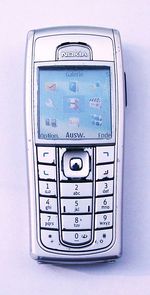 Yesterday I deleted all the remaining data on my old Nokia 6230i phone with the intent to give it away. It was my last feature phone (i. e. non-smartphone). My first feature phone was an 5130 in the late 90s. It made me think a bit about technology development.
Yesterday I deleted all the remaining data on my old Nokia 6230i phone with the intent to give it away. It was my last feature phone (i. e. non-smartphone). My first feature phone was an 5130 in the late 90s. It made me think a bit about technology development.I remember that at some point when I was a kid I asked myself if there are transportable phones. I was told they don't exist (which was not exactly true, but it's safe to say that they weren't widely available). Feature phones were nonexistent when I started to care about tech gadgets and today they're obsolete. (Some might argue that smartphones are the new mobile phones, but I don't think that's accurate. Essentially I think the name smartphone is misleading, because they are multi function devices where the phone functionality is just one – and hardly the most important one.)
I considered whether I should keep it in case my current smartphone breaks or gets lost so I have a quick replacement. However then I thought it would probably not do much good and decided it can go away as long as there are still people who would want to use it (the point where I could sell it has already passed). The reason is that the phone functionality is probably one of the lesser important ones of my smartphone and a feature phone wouldn't do much to help in case I loose it.
Of course feature phones are not the only tech gadgets that raised and became obsolete during my lifetime. CD-ROM drives, MP3 players, Modems, … I recently saw a documetary that was called “80s greatest gadgets” (this seems to be on Youtube, but unfortunately not available depending on your geolocation). I found it striking that almost every device they mentioned can be replaced with a smartphone today.
Something I wondered was what my own expectations of tech development were in the past. Surprisingly I couldn't remember that many. I would really be interested how I would've predicted tech development let's say 10 or 15 years ago and compare it to what really happened. The few things I can remember is that when I first heared about 3D printers I had high hopes (I haven't seen them come true until now) and that I always felt free software will become the norm (which in large parts it did, but certainly not in the way I expected). I'm pretty sure I didn't expected social media and I'm unsure about smartphones.
As I feel it's unfortunate I don't remember what I had expected in the past I thought I could write down some expectations now. I feel drone delivery will likely have an important impact in the upcoming years and push the area of online shopping to a whole new level. I expect the whole area that's today called “sharing economy” to rise and probably crash into much more areas. And I think that at some point robot technology will probably enter our everyday life. Admittedly none of this is completely unexpected but that's not the point.
If you have some interesting thoughts what tech we'll see in the upcoming years feel free to leave a comment.
Image from Rudolf Stricker / Wikimedia Commons
Posted by Hanno Böck
in Computer culture, English, Life
at
23:21
| Comment (1)
| Trackbacks (0)
Defined tags for this entry: development, featurephone, future, gadget, nokia, smartphone, technology
Friday, October 3. 2014
New laptop Lenovo Thinkpad X1 Carbon 20A7
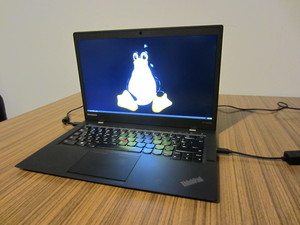 While I got along well with my Thinkpad T61 laptop, for quite some time I had the plan to get a new one soon. It wasn't an easy decision and I looked in detail at the models available in recent months. I finally decided to buy one of Lenovo's Thinkpad X1 Carbon laptops in its 2014 edition. The X1 Carbon was introduced in 2012, however a completely new variant which is very different from the first one was released early 2014. To distinguish it from other models it is the 20A7 model.
While I got along well with my Thinkpad T61 laptop, for quite some time I had the plan to get a new one soon. It wasn't an easy decision and I looked in detail at the models available in recent months. I finally decided to buy one of Lenovo's Thinkpad X1 Carbon laptops in its 2014 edition. The X1 Carbon was introduced in 2012, however a completely new variant which is very different from the first one was released early 2014. To distinguish it from other models it is the 20A7 model.Judging from the first days of use I think I made the right decision. I hadn't seen the device before I bought it because it seems rarely shops keep this device in stock. I assume this is due to the relatively high price.
I was a bit worried because Lenovo made some unusual decisions for the keyboard, however having used it for a few days I don't feel that it has any severe downsides. The most unusual thing about it is that it doesn't have normal F1-F12 keys, instead it has what Lenovo calls an adaptive keyboard: A touch sensitive line which can display different kinds of keys. The idea is that different applications can have their own set of special keys there. However, just letting them display the normal F-keys works well and not having "real" keys there doesn't feel like a big disadvantage. Beside that Lenovo removed the Caps lock and placed Pos1/End there, which is a bit unusual but also nothing I worried about. I also hadn't seen any pictures of the German keyboard before I bought the device. The ^/°-key is not where it's used to be (small downside), but the </>/| key is where it belongs(big plus, many laptop vendors get that wrong).
Good things:
* Lightweight, Ultrabook, no unnecessary stuff like CD/DVD drive
* High resolution (2560x1440)
* Hardware is up-to-date (Haswell chipset)
Downsides:
* Due to ultrabook / integrated design easy changing battery, ram or HD
* No SD card reader
* Have some trouble getting used to the touchpad (however there are lots of possibilities to configure it, I assume by playing with it that'll get better)
It used to be the case that people wrote docs how to get all the hardware in a laptop running on Linux which I did my previous laptops. These days this usually boils down to "run a recent Linux distribution with the latest kernels and xorg packages and most things will be fine". However I thought having a central place where I collect relevant information would be nice so I created one again. As usual I'm running Gentoo Linux.
For people who plan to run Linux without a dual boot it may be worth mentioning that there seem to be troublesome errors in earlier versions of the BIOS and the SSD firmware. You may want to update them before removing Windows. On my device they were already up-to-date.
Posted by Hanno Böck
in Computer culture, English, Gentoo, Life, Linux
at
23:05
| Comments (3)
| Trackbacks (0)
Monday, September 22. 2014
Mehr als 15 Cent
Seit Monaten können wir fast täglich neue Schreckensmeldungen über die Ebola-Ausbreitung lesen. Ich denke die muss ich hier nicht wiederholen.
Ebola ist für viele von uns - mich eingeschlossen - weit weg. Und das nicht nur im räumlichen Sinne. Ich habe noch nie einen Ebola-Patienten gesehen, über die betroffenen Länder wie Sierra Leone, Liberia oder Guinea weiß ich fast nichts. Ähnlich wie mir geht es sicher vielen. Ich habe viele der Meldungen auch nur am Rande wahrgenommen. Aber eine Sache habe ich mitgenommen: Das Problem ist nicht das man nicht wüsste wie man Ebola stoppen könnte. Das Problem ist dass man es nicht tut, dass man denen, die helfen wollen - oftmals unter Einsatz ihres eigenen Lebens - nicht genügend Mittel zur Verfügung stellt.
Eine Zahl, die ich in den letzten Tagen gelesen habe, beschäftigt mich: Die Bundesregierung hat bisher 12 Millionen Euro für die Ebola-Hilfe zur Verfügung gestellt. Das sind umgerechnet etwa 15 Cent pro Einwohner. Mir fehlen die Worte das adäquat zu beschreiben. Es ist irgendwas zwischen peinlich, verantwortungslos und skandalös. Deutschland ist eines der wohlhabendsten Länder der Welt. Vergleiche mit Bankenrettungen oder Tiefbahnhöfen erspare ich mir jetzt.
Ich habe gestern einen Betrag an Ärzte ohne Grenzen gespendet. Ärzte ohne Grenzen ist soweit ich das wahrnehme im Moment die wichtigste Organisation, die vor Ort versucht zu helfen. Alles was ich über Ärzte ohne Grenzen weiß gibt mir das Gefühl dass mein Geld dort gut aufgehoben ist. Es war ein Betrag, der um mehrere Größenordnungen höher als 15 Cent war, aber es war auch ein Betrag, der mir mit meinen finanziellen Möglichkeiten nicht weh tut.
Ich finde das eigentlich nicht richtig. Ich finde es sollte selbstverständlich sein dass in so einer Notsituation die Weltgemeinschaft hilft. Es sollte nicht von Spenden abhängen, ob man eine tödliche Krankheit bekämpft oder nicht. Ich will eigentlich mit meinen Steuergeldern für so etwas zahlen. Aber die Realität ist: Das geschieht im Moment nicht.
Ich schreibe das hier nicht weil ich betonen möchte wie toll ich bin. Ich schreibe das weil ich Dich, der das jetzt liest, bitten möchte, das selbe tust. Ich glaube jeder, der hier mitliest, ist in der Lage, mehr als 15 Cent zu spenden. Spende einen Betrag, der Dir angesichts Deiner finanziellen Situation bezahlbar und angemessen erscheint. Jetzt sofort. Es dauert nur ein paar Minuten:
Online für Ärzte ohne Grenzen spenden
(Ich freue mich wenn dieser Beitrag verbreitet / geteilt wird - zum Beispiel mit dem Hashtag #mehrals15cent)
Ebola ist für viele von uns - mich eingeschlossen - weit weg. Und das nicht nur im räumlichen Sinne. Ich habe noch nie einen Ebola-Patienten gesehen, über die betroffenen Länder wie Sierra Leone, Liberia oder Guinea weiß ich fast nichts. Ähnlich wie mir geht es sicher vielen. Ich habe viele der Meldungen auch nur am Rande wahrgenommen. Aber eine Sache habe ich mitgenommen: Das Problem ist nicht das man nicht wüsste wie man Ebola stoppen könnte. Das Problem ist dass man es nicht tut, dass man denen, die helfen wollen - oftmals unter Einsatz ihres eigenen Lebens - nicht genügend Mittel zur Verfügung stellt.
Eine Zahl, die ich in den letzten Tagen gelesen habe, beschäftigt mich: Die Bundesregierung hat bisher 12 Millionen Euro für die Ebola-Hilfe zur Verfügung gestellt. Das sind umgerechnet etwa 15 Cent pro Einwohner. Mir fehlen die Worte das adäquat zu beschreiben. Es ist irgendwas zwischen peinlich, verantwortungslos und skandalös. Deutschland ist eines der wohlhabendsten Länder der Welt. Vergleiche mit Bankenrettungen oder Tiefbahnhöfen erspare ich mir jetzt.
Ich habe gestern einen Betrag an Ärzte ohne Grenzen gespendet. Ärzte ohne Grenzen ist soweit ich das wahrnehme im Moment die wichtigste Organisation, die vor Ort versucht zu helfen. Alles was ich über Ärzte ohne Grenzen weiß gibt mir das Gefühl dass mein Geld dort gut aufgehoben ist. Es war ein Betrag, der um mehrere Größenordnungen höher als 15 Cent war, aber es war auch ein Betrag, der mir mit meinen finanziellen Möglichkeiten nicht weh tut.
Ich finde das eigentlich nicht richtig. Ich finde es sollte selbstverständlich sein dass in so einer Notsituation die Weltgemeinschaft hilft. Es sollte nicht von Spenden abhängen, ob man eine tödliche Krankheit bekämpft oder nicht. Ich will eigentlich mit meinen Steuergeldern für so etwas zahlen. Aber die Realität ist: Das geschieht im Moment nicht.
Ich schreibe das hier nicht weil ich betonen möchte wie toll ich bin. Ich schreibe das weil ich Dich, der das jetzt liest, bitten möchte, das selbe tust. Ich glaube jeder, der hier mitliest, ist in der Lage, mehr als 15 Cent zu spenden. Spende einen Betrag, der Dir angesichts Deiner finanziellen Situation bezahlbar und angemessen erscheint. Jetzt sofort. Es dauert nur ein paar Minuten:
Online für Ärzte ohne Grenzen spenden
(Ich freue mich wenn dieser Beitrag verbreitet / geteilt wird - zum Beispiel mit dem Hashtag #mehrals15cent)
Posted by Hanno Böck
in Life, Politics
at
16:48
| Comments (0)
| Trackbacks (0)
Defined tags for this entry: aerzteohnegrenzen, afrika, ebola, guinea, liberia, mehrals15cent, sierraleone
Tuesday, August 5. 2014
Las Vegas
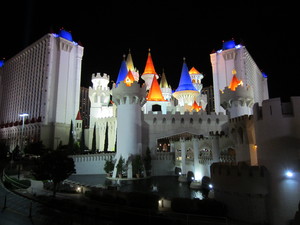
My hotel looks like a Disneyland castle - just much larger.
Las Vegas is probably a place I would've never visited on its own. I consider myself a rationalist person and therefore I see gambling mostly as an illogical pursuit. In the end your chances of winning are minimal because otherwise the business wouldn't work. I hadn't imagined how huge the casino business in Las Vegas is. Large parts of the city are just one large casino after another - and it doesn't stop there, because a couple of cities around Vegas literally are made of casinos.
Beside seeing some of the usual tourist attractions (Hoover Dam, Lake Mead), I spend the last couple of days also finding out that there are some interesting solar energy projects nearby. Also a large Star Trek convention> was happening the past days where I attended on the last day.

A Nintendo test cardrige at A Gamer's Paradise
Pictures from Las Vegas
Pictures from A Gamer's Paradise
Pictures from Pinball Hall of Fame
Posted by Hanno Böck
in Computer culture, English, Life, Retro Games
at
07:39
| Comment (1)
| Trackbacks (0)
Thursday, April 24. 2014
Easterhegg talk on TLS
 Last weekend I was at the Easterhegg in Stuttgart, an event organized by the Chaos Computer Club. I had a talk with the title "How broken is TLS?"
Last weekend I was at the Easterhegg in Stuttgart, an event organized by the Chaos Computer Club. I had a talk with the title "How broken is TLS?"This was quite a lucky topic. I submitted the talk back in January, so I had no idea that the Heartbleed bug would turn up and raise the interest that much. However, it also made me rework large parts of the talk, because after Heartbleed I though I had to get a much broader view on the issues. The slides are here as PDF, here as LaTeX and here on Slideshare.
There's also a video recording here (media.ccc.de) and also on Youtube.
I also had a short lightning talk with some thoughs on paperless life, however it's only in German. Slides are here (PDF), here (LaTeX) and here (Slideshare). (It seems there is no video recording, if it appears later I'll add the link.)
Posted by Hanno Böck
in Computer culture, Cryptography, English, Life, Security
at
16:37
| Comments (0)
| Trackback (1)
Defined tags for this entry: ccc, cryptography, easterhegg, papierlos, security, slides, ssl, stuttgart, talk, tls
Monday, April 14. 2014
Freelance Journalist looking for Jobs
If you don't know who I am and what I do, let me quickly introduce myself:
I live in Berlin and work as a freelance journalist. I sometimes write for the newspapers taz, the online version of the Zeit and I'm a regular author at the IT news magazine Golem.de. Currently, my main topics are IT security and cryptography. I cover those topics both for general interest media and for experts. I also write about some completely different topics like climate change, energy politics, science and problems in medicine and whatever I happen to find interesting. I maintain an extensive list of articles I wrote in the past on my website and just recently added an English version with Google Translate links to my articles.
A notable article I wrote lately was a large piece on the security of various encryption algorithms after the Snowden revelations which got around 900.000 visits. In the past days I covered the Heartbleed story extensively and am happy to say that I wrote the first article in German language that appeared on Google News.
I'm quite happy with my job right now. Especially my cooperation with Golem.de is going very well. I have enough topics to write about, have some new opportunities in sight and earn enough money from my work to pay my expenses However, all my current employers publish exclusively in German. I sometimes cover topics where I'd wish that I could target an international audience and where I'd like to publish in English language.
If you are working for any kind of media in English language and you think my work may be interesting for you: Please get in touch with me. Of course if you work for any kind of media in German language and think the same you may also get in touch with me.
I'm aware that this is difficult. Anyone who decides to cooperate with me on this needs to be aware: I'm no native speaker. I think my English language skills are decent, but they are far from perfect. My work probably requires more spell checking and editing than others.
I live in Berlin and work as a freelance journalist. I sometimes write for the newspapers taz, the online version of the Zeit and I'm a regular author at the IT news magazine Golem.de. Currently, my main topics are IT security and cryptography. I cover those topics both for general interest media and for experts. I also write about some completely different topics like climate change, energy politics, science and problems in medicine and whatever I happen to find interesting. I maintain an extensive list of articles I wrote in the past on my website and just recently added an English version with Google Translate links to my articles.
A notable article I wrote lately was a large piece on the security of various encryption algorithms after the Snowden revelations which got around 900.000 visits. In the past days I covered the Heartbleed story extensively and am happy to say that I wrote the first article in German language that appeared on Google News.
I'm quite happy with my job right now. Especially my cooperation with Golem.de is going very well. I have enough topics to write about, have some new opportunities in sight and earn enough money from my work to pay my expenses However, all my current employers publish exclusively in German. I sometimes cover topics where I'd wish that I could target an international audience and where I'd like to publish in English language.
If you are working for any kind of media in English language and you think my work may be interesting for you: Please get in touch with me. Of course if you work for any kind of media in German language and think the same you may also get in touch with me.
I'm aware that this is difficult. Anyone who decides to cooperate with me on this needs to be aware: I'm no native speaker. I think my English language skills are decent, but they are far from perfect. My work probably requires more spell checking and editing than others.
Thursday, April 10. 2014
Vortrag zu gehackten Webanwendungen und Malware
Ich halte morgen (11.04.2014) einen Vortrag im Hackerspace AFRA in Berlin. Hier die Ankündigung:
Beliebte Webanwendungen und Content-Management-Systeme haben regelmäßig Sicherheitslücken. Nutzer müssen diese Anwendungen regelmäßig updaten, aber viele Betreiber von Webseiten sind sich dessen nicht bewusst. Im Rahmen des Betriebs von Servern mit einigen Hundert Kunden habe ich das Tool FreeWVS entwickelt, mit dem sich Webanwendungen mit bekannten Sicherheitslücken erkennen lassen. Wenn man Updates versäumt, tauchen fast zwangsweise irgendwann gehackte Webanwendungen auf. Diese aufzuspüren ist aber nicht unbedingt trivial. Wenn es zu spät ist, wird der eigene Server unter Umständen zur Spamschleuder oder wird für DDoS-Attacken missbraucht.
Beginn 20:00 Uhr, die AFRA befindet sich in der Herzbergstraße 55, nahe der Tram-Haltestelle Haltestelle Herzbergstraße/Siegfriedstraße.
Update: Die Slides gibt's hier als PDF, hier als Latex-Source und auf Slideshare.
Beliebte Webanwendungen und Content-Management-Systeme haben regelmäßig Sicherheitslücken. Nutzer müssen diese Anwendungen regelmäßig updaten, aber viele Betreiber von Webseiten sind sich dessen nicht bewusst. Im Rahmen des Betriebs von Servern mit einigen Hundert Kunden habe ich das Tool FreeWVS entwickelt, mit dem sich Webanwendungen mit bekannten Sicherheitslücken erkennen lassen. Wenn man Updates versäumt, tauchen fast zwangsweise irgendwann gehackte Webanwendungen auf. Diese aufzuspüren ist aber nicht unbedingt trivial. Wenn es zu spät ist, wird der eigene Server unter Umständen zur Spamschleuder oder wird für DDoS-Attacken missbraucht.
Beginn 20:00 Uhr, die AFRA befindet sich in der Herzbergstraße 55, nahe der Tram-Haltestelle Haltestelle Herzbergstraße/Siegfriedstraße.
Update: Die Slides gibt's hier als PDF, hier als Latex-Source und auf Slideshare.
Saturday, January 18. 2014
Laos, Thailand, Malaysia and back home
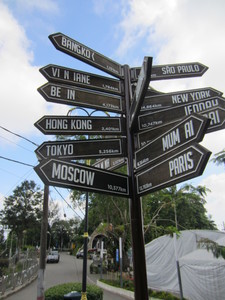
These signs in Penang/Malaysia were quite a good symbol for my trip.
I entered Laos from China, but I didn't spend a lot of time in Laos. The main reason was that I was quite frustrated with the weather. It was a comparatively cold winter in southern China and Laos and the buildings there are not really isolated at all and heating usually doesn't exist. While the days were all sunny and nice, the nights were sometimes quite tough. In Laos, usually the only mode of transport are buses and minibuses. I crossed the border at Houay Xai and quickly moved on to Bangkok by bus and train.
Travelling in Laos and Thailand was quite a different experience when compared to Kazakhstan and China. For the first half of my trip, I mostly felt like "the stranger going to places rarely visited by strangers". In China, even at touristy places there were mostly domestic tourists. Laos and Thailand are flooded with western tourists, so I was more like "the western guy going to places everyone else is going". Honestly, I felt much more comfortable with the first role. Malaysia was somewhat in-between. The most important thing I was looking for in this part of Asia was mostly nature and rainforests.
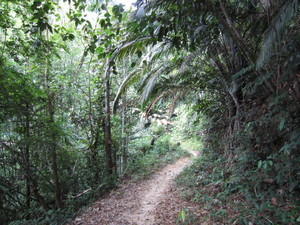
Rainforest in Malaysia.
If you know me, you know that I try to avoid flying. But it was clear that doing this trip without would be close to impossible. So I flew back from Kuala Lumpur in Malaysia earlier this week.
While I've seen a lot and experienced a lot, at the end I was at a point where I really didn't want to continue any more. I have a lot of respect and get inspiration from people people who consider themselves digital nomads, permanent travelers or something alike and I though a lot about that during travelling and in the months before. I'll probably write some more about that at a later point, as I find it quite desirable to organize life in a way to be less dependent on a fixed living spot. But for me, this has limits and I know where they are.
Posted by Hanno Böck
in English, Life
at
13:02
| Comment (1)
| Trackbacks (0)
Defined tags for this entry: asia, asia2013, kualalumpur, laos, malaysia, rainforest, thailand, travel
Tuesday, January 7. 2014
Boten - a chinese casino ghost town in Laos
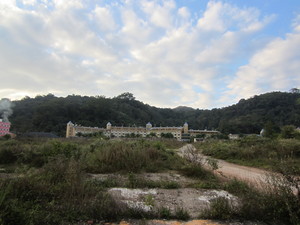
This hotel still takes customers, although there probably aren't many
Right behind the border in Laos is the small town Boten. There's a quite interesting story behind this place. A couple of years ago, this was a place of casinos for chinese gamblers. In China itself casinos are forbidden, so this gained quite some popularity. A couple of luxury Hotels and other facilities for the chinese gamblers emerged. However, some conflicts were arising. The casinos sometimes held chinese gamblers unable to pay their gambling debt as hostages. Chinese authorities were unhappy with this and pressured the laotian authorities to shut the place down, which finally happened in 2011.
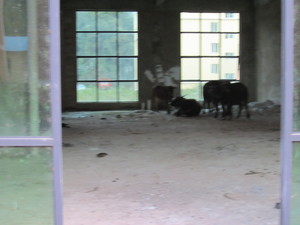
In this former hotel only cows sleep these days
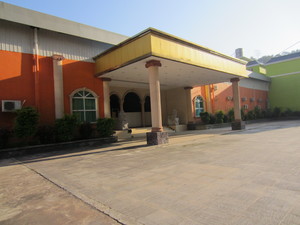
A Casino - empty today.
It was definitely one of the more interesting places on my trip.
Pictures from Boten
Saturday, December 21. 2013
Hallstatt in China
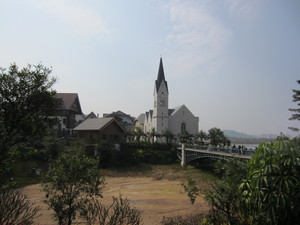
Hallstatt in China's Guangdong province
It was a bit tricky to get there. I found only limited information online. The place is near Luoyang, which is part of an area called Boluo, near the town Huizhou. Getting to Huizhou was mostly hassle-free, there are many trains every day from Guangzhou and it takes about two hours. How to come to Luoyang/Boluo is another story. I had two bus numbers I found in some Internet forums, but I couldn't find them at the train station. So either the information was wrong or the buses with that numbers are departing from another place in Huizhou. I also had some GPS coordinates I found online of the copycat Hallstatt, but it turned out later that they were not very accurate.
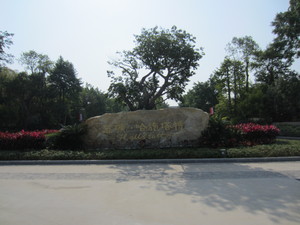
The entrance
What is interesting to know is that this place isn't primarily a tourist destination. It's a housing development, people are supposed to live here. However, I think nobody lives here yet, because except for the town's center, everything is still in construction. There are a number of similar projects in China. Tianducheng in eastern China, which rebuilts parts of Paris, has gotten quite a lot of media attention lately as an example for the Chinese housing bubble. Almost nobody lives there and it's mostly a ghost town. As the chinese Hallstatt isn't yet ready to house anyone, the future will tell if it'll fall to the same fate.
There were a number of things that made this place weird. The most obvious thing: You usually don't see tropical plants in an austrian town. I have no idea why they had a (fake/nonworking) red, british-style phone booth. Maybe for a chinese Britain isn't that far from Austria after all. Although this place isn't primarily meant as a tourist destination, it certainly attracts a lot of them. It was quite crowded. I haven't seen anyone who looked like being from Austria though.
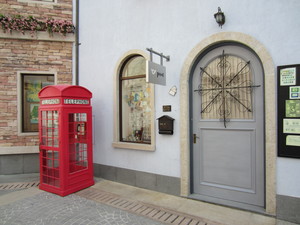
British style fake phone booth
I'd like to finish with a quick comment. When reading western news commenting about this case and others, they're often quick in condemning this kind of "copycat" culture. I think one needs to be careful with that. The importance of the "original" is something that is deeply rooted in cultural norms and traditions. Sticking to the original is something that's probably more important in European cultures than in China. But I don't think either of them is right or wrong, it's just a different approach to culture. After all, it doesn't hurt anybody if someone is rebuilding Austrian villages in China. Also, there is almost certainly no legal issue at stake here. While it may be debatable if a town's layout can be covered by copyright, Hallstatt is a historic city. So if there is any copyright on it, it's already expired.
Pictures from Luoyang
Pictures from Chinese Hallstatt
Some Links:
Blog entry about Hallstatt / China on thechinachronicle.com
Blog entry about Hallstatt / China on liongrass.hk
Friday, December 13. 2013
Fastest overland route from Europe to China
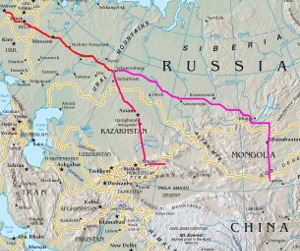 The well-known way of getting from Europe to China overland is the transsiberian railway. However, I noted that the route through Kazakhstan I took is the quickest way to get to China by train and bus. I thought I'd write that up:
The well-known way of getting from Europe to China overland is the transsiberian railway. However, I noted that the route through Kazakhstan I took is the quickest way to get to China by train and bus. I thought I'd write that up:- Take train EC 43 from Berlin Hauptbahnhof (09:37 on Monday, Berlin time) to Warsaw Wschodnia, change to train D 10SZ (15:28). If you - like me - feel that the time to switch trains is a bit risky in case of delaqys, you can take the earlier Beriln-Warsaw-train EC 41 (06:37 until 12:08). There's also a direct Berlin-Moscow-train D 50472 (Berlin 04:28, Moskwa Belorusskaja 10:33), but it's often sold out early.
- Spend some time in Moscow and then take the Metro Line 5 (Circular Line) to Komsol'skaya (Metro of Kazasky railway station)
- Take train 090У from Moscow Kazansky (18:48 on Tuesday, Moscow time) to Petropavl/Petropavlovsk in Kazakhstan (09:46 on Thursday, Astana/Almaty time). Note that this only works every second Tuesday - you may choose other days where this train goes, but then other options may not work.
- Take train 152T from Petropavl (13:48 on Thursday, Astana/Almaty time) to Almaty (22:28 on Friday, Astana/Almaty time).
- Take bus number 100 to Sayran bus station and hope that they'll sell you a ticket late in the evening for the bus next morning. Find a place to sleep (but not very long).
- Take bus from Astana Sayran bus station (07:00 on Friday, Astana/Almaty time) to Yining (approx. 21:00 on Friday, Beijing time). You're in China.
With the transsiberian, you can leave Berlin on Monday (same options as above until Moscow) and take the D4ZJ direct train from Moscow to Beijing. You will enter China in Erlian on the next Monday at 00:47. So this makes almost 7 days vs. about 4 and a half days.
I wouldn't recommend anyone doing that. Better spend some time on the way and see some places in Russia or Kazakhstan. Also it should be noted that one obvious reason for being faster is that you'll enter China at a place much further in the west. And getting to the main part of china (the western part is much less inhabited than the eastern part and all big cities are in the east) can be somewhat troublesome. Still, I thought it might be of interest to document the fastest overland way from Europe to China.
I always assumed the starting point Berlin, obviously because I live there, adapting that to other starting places should be trivial. For example you can usually easily (and for a comparatively cheap price) reach Berlin by Eurolines bus in a day from other major european cities like Paris or London.
Saturday, December 7. 2013
Xi'an, capsule hostel, chinese pyramids and more
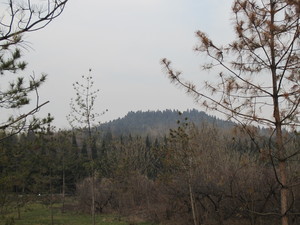
The great pyramid of China (I admin it doesn't look that spectacular and pyramid-like)
Between Dunhuang and Lanzhou, I took what is called the "hard seat" class for a 14 hour ride (not overnight). I can quote Wikivoyage on that:
"Traveling in a seat (hard or soft-class) means you will share the car space with lots of locals. You will most likely encounter smokers, loud noise, and constant activity in the aisle while you try to sleep. *Do not* travel hard class if you are uncomfortable with these settings."
While I certainly was an interesting experience, it is not exactly one I'd like to repeat. It was challenging and I was quite happy when I finally arrived.
With my arrival in Xi'an, finally I noticed that I approach the warmer zones of China. While not really "summer-warm", I apprechiated not having to wear winter clothes all the time. Appart from that, Xi'an was quite different from the other cities I've visited before. It is in many small ways much more like a western city (and, to be not mistaken, in many ways this is a good thing - better hygiene, less dangerous traffic, no smoking in non-smoking zones). And regarding my last blog post, yes, coffee is usually available, although often expensive.
Xi'an is also home of one of Chinas most popular tourist attractions, the so-called terracotta warriors and - not that well known - the Chinese pyramids. I didn't know that there are pyramids in China, so found that worth seeing. Unlike pyramids in other places of the world, the chinese pyramids are not buildings, they are artificial hills. The biggest one, near the terracotta warriors, is the mausoleum of Chinas first emperor Qin Shi Huang.
My initial plan was to visit the pyramid and then decide if I still had time and motivation to see the terracotta warriors. I took the bus to the terracotta warriors and walked the roughly two kilometers to the pyramid. Turned out my planning was not really how one was supposed to do things. Going to the pyramid is only possible with an entrance ticket for the terracotta warrior museum - and you cannot buy it at the entrance of the pyramid area. There's a free shuttle service which I then took to get the ticket and drive back.
The pyramid doesn't look that spectacular and there's hardly a spot where you can actually see it's a pyramid. It once was much bigger, but during the centuries, the earth got compressed and it became smaller. I walked around a lot, the area around is a nice park.
As it is common amongst tourist destinations probably everywhere in the world, there is a huge amount of people who want to sell you things - from terracotta warrior replica in all sizes (including ones in original size and made mostly out of the same materials than the original ones) to the various tour guides. I refused all these offers and preferred to find my own way. One more thing notable: This isn't mainly a tourist spot for foreign tourist. The vast majority were domestic tourists.
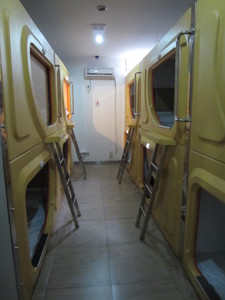
Capsule Hotel in Xi'an
While writing this, I'm in the highspeed train from Xi'an to Guangzhou (taking only 8 hours). I've been to Guangzhou before, and I'm not going there not mainly because I want to see something there. I have a double-entry 2 x 30 days visa and from Guangzhou, I intend to make a quick hop to Hong Kong. Although part of China, in visa issues Hong Kong is like going to another country. So by going to Hong Kong, I have another 30 days to spend in China. Arriving in Guangzhou, I can also finally leave any traces of the northern hemisphere winter behind myself. It has comfortable temperatures all year round.
Pictures from Xian
Pictures from Guangzhou
Posted by Hanno Böck
in English, Life
at
04:06
| Comments (0)
| Trackbacks (0)
Defined tags for this entry: asia, asia2013, capsulehotel, china, pyramid, terracottawarriors, train, xian
Monday, December 2. 2013
No coffee in northwest China
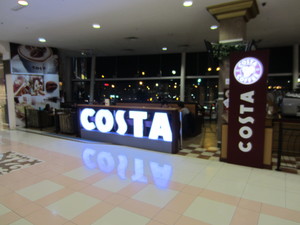
Costa Coffee is expanding to Asia - this one's in Astana
When travelling, I usually have my own coffee making equipment, which consists of a couple of coffee filters, a collapsable filter holder, some coffee powder and some coffee creamer powder (which doesn't make a very delicious coffee and I prefer real milk or soy milk if possible, but it's a reasonable compromise when travelling).
I was running out of coffee powder shortly after I entered China. I really hadn't expected that it would be a problem. After all, the biggest international coffee chains, Starbucks and Costa Coffee, are flooding eastern and southern China with their restaurants and Chinese chains and independent coffee houses are trying to keep up with that. Well, the problem is that I entered China in the far northwest. And the Chinese love for coffee hasn't made it there yet.
I could hardly believe this, but between Yining and Dunhuang, I didn't find any coffee. None at all. Not in the form of coffee powder and not in brewed form. Yeah, supermarkets have a large collection of soluble instant coffee, most of it Nescafe and also some Chinese brands. But I refuse to call that stuff coffee. Most of it contains more sugar than anything else. When you get coffee in restaurants at all, you can bet it's also instant coffee. I checked where the next Starbucks is: In Xi'an, thousands of kilometers away. I checked for the next Costa Coffee: Also in Xi'an. (I'm on my way to Xi'an now - no, not just because of the coffee, it was my plan anyway.)
After all, I bought some non-sugared instant coffee. No, I wasn't happy with it, but it seemed it was the best I could get.
Lesson learned: There's just no coffee in northwest China.
Saturday, November 30. 2013
Through Western China and no train tickets from Urumqi
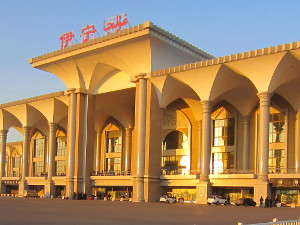
Train station in Yining
I took the train from Yining to Urumqi. My original plan was to move along quite fast and directly take the next train to Xi'an. But that didn't really work. I had to find out that all train tickets for the upcoming days to every location east of Urumqi were sold out. This was kind of a déjà vu. Last time I was in China I had the plan to travel this way in the other direction - and no tickets were available. Reading local news, this situation might improve 2014, when a new highspeed train line opens between Urumqi and Lanzhou. I didn't want to wait that long though.
However, this time I knew that there are alternatives - by taking the bus. I took a bus to the town Dunhuang, which is about 1,000 kilometers east of Urumqi.
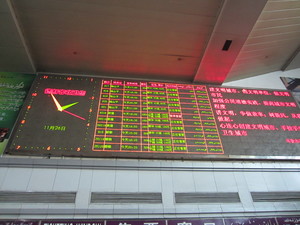
Bus times in Urumqi
The bus trip through the Xinjiang desert passed a lot of wind turbines. While China is often portrayed as the environmental bad guy, one shouldn't fail to recognize that it's also the world leader in building renewable energies. However, the many Xinjiang wind turbine fields also told the other not so green side of the Chinese renewable boom: Many of the turbines were just standing still. The most likely reason: China is building up wind power faster than it's caring for grid integration. I'm used to that look in Germany - wind power there is also often downregulated, because grid integration is not keeping up with the installation of new wind energy. But it was quite obvious that this problem is far bigger here in China's desert.
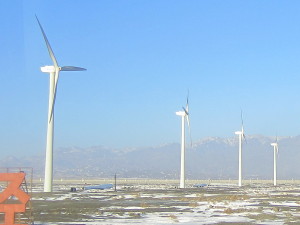
Wind energy in Xinjiang
Tomorrow I'll take the train to Lanzhou.
Pictures from Yining
Pictures from Dunhuang
Pictures from wind power turbines in the Xinjiang province
Pictures from Lanzhou
(Page 1 of 18, totaling 256 entries)
» next page